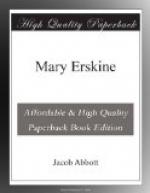At length, when the breakfast was ready they all sat down around the table to eat it, except the baby. He remained in the trundle-bed, playing with his play-things. His play-things consisted of three or four smooth pebble stones of different colors, each being of about the size of an egg, which his mother had chosen for him out of the brook, and also of a short piece of bright iron chain. The chain was originally a part of a harness, but the harness had become worn out, and Albert had brought in the chain and given it to the baby. The baby liked these play-things very much indeed,—both the pebbles and the chain. When he was well, and neither hungry nor sleepy, he was never tired of playing with them,—trying to bite them, and jingling them together.
“Now,” said Mary Erskine to the children, as they were sitting at the table, at the close of the breakfast, and after Thomas had gone away, “you may go out and play for an hour while I finish my morning work, and put the baby to sleep, and then I want you to come in and have a school.”
“Who shall be the teacher?” said Mary Bell.
“You shall be one,” said Mary Erskine.
“Are you going to have two teachers?” asked Mary Bell. “If you do, then we can’t have any scholars;—for the baby is not old enough to go to school.”
“I know it,” said Mary Erskine, “but we can have three scholars without him.”
“Who shall they be?” asked Mary Bell.
“You and I, and Bella,” answered Mary Erskine. “I will tell you what my plan is. I expect that I shall conclude to stay here, and live in this house alone for some years to come, and the children can not go to school, for there is now nobody to take them, and it is too far for them to go alone. I must teach them myself at home, or else they can not learn. I am very sorry indeed now that I did not learn to read and write when I was a child: for that would have saved me the time and trouble of learning now. But I think I can learn now. Don’t you think I can, Mary?”
“Oh, yes, indeed,” said Mary Bell, “I am sure you can. It is very easy to read.”
“I am going to try,” continued Mary Erskine, “and so I want you to teach me. And while you are teaching me, Bella may as well begin at the same time. So that you will have two scholars.”
“Three—you said three scholars,” rejoined Mary Bell.
“Yes,” said Mary Erskine. “You shall be the third scholar. I am going to teach you to draw.”
“Do you know how to draw?” asked Mary Bell, surprised.
“No,” said Mary Erskine, “but I can show you how to learn.”
“Well,” said Mary Bell, “I should like to learn to draw very much indeed. Though I don’t see how any body can teach a thing unless they can do it themselves.”
“Sometimes they can,” said Mary Erskine. “A man may teach a horse to canter, without being able to canter himself.”




